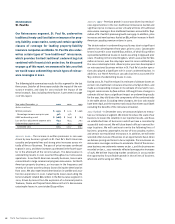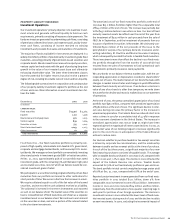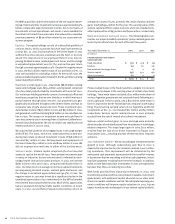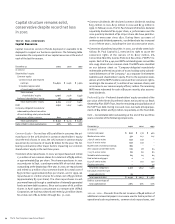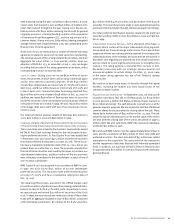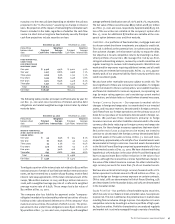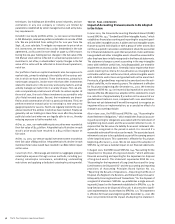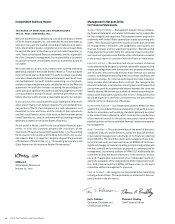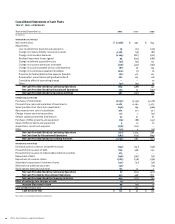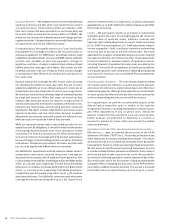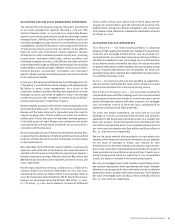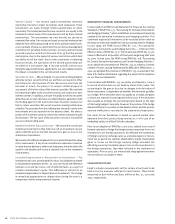Travelers 2001 Annual Report Download - page 40
Download and view the complete annual report
Please find page 40 of the 2001 Travelers annual report below. You can navigate through the pages in the report by either clicking on the pages listed below, or by using the keyword search tool below to find specific information within the annual report.
techniques. Our holdings are diversified across industries, and con-
centrations in any one company or industry are limited by
parameters established by senior management as well as by statu-
tory requirements.
Included in our equity portfolio at Dec. 31, 2001 was our investment
in Old Mutual plc, received as partial consideration in our sale of F&G
Life. We are prohibited from selling this for one year from the
Sept. 28, 2001 sale date. To mitigate our exposure to price risk on
this investment, we entered into a collar (embedded in the sale
agreement), as discussed in more detail on page 15 of this report.
During the one-year holding period, changes in the fair value of the
Old Mutual stock will be reflected in unrealized appreciation of
investments, net of tax, in shareholders’ equity. Changes in the fair
value of the collar will be reflected in discontinued operations,
net of tax.
Our portfolio of venture capital investments also has exposure to
market risks, primarily relating to the viability of the various enti-
ties in which we have invested. These investments, primarily in
early-stage companies, involve more risk than other investments
related to downturns in the economy and equity markets, and we
actively manage our market risk in a variety of ways. First, we allo-
cate a comparatively small amount of funds to venture capital. At
the end of 2001, the cost of these investments accounted for only
4% of total invested assets. Second, the investments are diversi-
fied to avoid concentration of risk in a particular industry. Third, we
perform extensive research prior to investing in a new venture to
gauge prospects for success. Fourth, we regularly monitor the oper-
ational results of the entities in which we have invested. Finally, we
generally sell our holdings in these firms soon after they become
publicly traded and when we are legally able to do so, thereby
reducing exposure to further market risk.
At Dec. 31, 2001, our marketable equity securities were recorded at
their fair value of $1.41 billion. A hypothetical 10% decline in each
stock’s price would have resulted in a $141 million impact on
fair value.
At Dec. 31, 2001, our venture capital investments were recorded at
their fair value of $859 million. A hypothetical 10% decline in each
investment’s fair value would have resulted in an $86 million impact
on fair value.
Catastrophe Risk – We manage and monitor our aggregate property
catastrophe exposure through various methods, including pur-
chasing catastrophe reinsurance, establishing underwriting
restrictions and applying a dedicated catastrophe-pricing model.
the st. paul companies
Impact of Accounting Pronouncements to Be Adopted
in the Future
In June 2001, the Financial Accounting Standards Board (FASB)
issued SFAS No. 142, “Goodwill and Other Intangible Assets,” which
establishes financial accounting and reporting for acquired good-
will and other intangible assets. It addresses how intangible assets
that are acquired individually or with a group of other assets (but
not those acquired in a business combination) should be accounted
for in financial statements upon their acquisition. It also addresses
how goodwill and other intangible assets should be accounted for
after they have been initially recognized in the financial statements.
The statement changes current accounting in the way intangible
items with indefinite useful lives, including goodwill, are tested for
impairment on an annual basis. Generally, it also requires that those
assets meeting the criteria for classification as intangible with
estimable useful lives will be amortized, while intangible assets
with indefinite useful lives and goodwill will not be amortized.
Previously, all goodwill was required to be amortized over the esti-
mated useful life, not to exceed 40 years. The statement is effective
for fiscal years beginning after December 15, 2001. We intend to
implement SFAS No. 142 in the period during which its provisions
become effective. We expect our adoption of this statement to result
in a reduction of approximately $30 million in the amount of our
goodwill amortization in 2002, compared with 2001 amortization.
We have not yet determined if we will be required to recognize an
impairment loss on implementation, as a cumulative effect of a
change in accounting principle.
Also in June 2001, the FASB issued SFAS No. 143, “Accounting for
Asset Retirement Obligations,” which establishes financial account-
ing and reporting for obligations associated with the retirement of
tangible long-lived assets and the associated retirement costs. It
requires that the fair value of a liability for an asset retirement obli-
gation be recognized in the period in which it is incurred if a
reasonable estimate of fair value can be made. The associated asset
retirement costs are to be capitalized as part of the carrying amount
of the long-lived asset. This statement is effective for fiscal years
beginning after June 15, 2002. We do not expect the adoption of
SFAS No. 143 to have a material impact on our financial statements.
In August 2001, the FASB issued SFAS No. 144, “Accounting for the
Impairment or Disposal of Long-Lived Assets,” which addresses
financial accounting and reporting for the impairment or disposal
of long-lived assets. This statement supersedes SFAS No. 121,
“Accounting for the Impairment of Long-Lived Assets and for Long-
Lived Assets to be Disposed Of,” and the accounting and reporting
provisions of Accounting Principles Board Opinion No. 30,
“Reporting the Results of Operations – Reporting the Effects of
Disposal of a Segment of a Business, and Extraordinary, Unusual or
Infrequently Occurring Events and Transactions,” for the disposal of
a segment of a business. SFAS No. 144 establishes a single account-
ing model, based on the framework established in SFAS No. 121, for
long-lived assets to be disposed of by sale. It also resolves signifi-
cant implementation issues related to SFAS No. 121. This statement
is effective for fiscal years beginning after December 15, 2001. We
have not yet determined the impact of adopting this statement.
The St. Paul Companies 2001 Annual Report38


